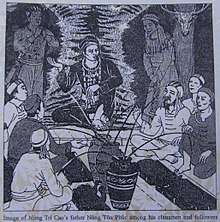Nong Quanfu
| Nong Quanfu | |||||||||
|---|---|---|---|---|---|---|---|---|---|
|
儂存福 Emperor of the Kingdom of Longevity (長生國) | |||||||||
 An illustration of Nong Quanfu and his followers in a Vietnamese book | |||||||||
| Emperor of the Kingdom of Longevity (長生國) | |||||||||
| Reign | 1038 – 1039 | ||||||||
| Predecessor | - | ||||||||
| Successor | Nong Zhigao | ||||||||
| Born |
? Guangyuan, (modern-day Caobang, Vietnam) | ||||||||
| Died |
1039 Thăng Long, modern-day Hanoi, Vietnam | ||||||||
| Spouse | A Nong Enlightened and Virtuous Empress (明德皇后) | ||||||||
| Issue |
Nong Zhigao (儂智高) Nong Zhicong (儂智聰) Nong Zhoguang (儂智光) | ||||||||
| |||||||||
| Religion | Shamanism, Animism | ||||||||
Nong Quanfu (Chinese: 儂全福; pinyin: Nóng Quánfú, Zhuang: Nungz Cienzfuk, Vietnamese: Nùng Tồn Phúc ; ?-1039) was a Nùng/Zhuang chieftain and zhou-level official[1] of Guangyuan located in the modern-day Cao Bang in the 11th century AD. He was the father of the Nùng/Zhuang chieftain Nong Zhigao, who revolted against Annamese rule in 1048, established the Kingdom of the Great South, and besieged Guangzhou for two months in 1052.[2][3]
Biography
Nong Quanfu was a son of Nong Minfu (儂民富), a local chieftain of Guangyuan. Nong Minfu received the titles minister of works (司空) and grand master of splendid happiness bearing the golden pocket with purple trimming (金紫光祿大夫) from the Song court, which he eventually passed on to his son, Nong Quanfu.[4] Nong Quanfu was then granted the additional authority to rule Thang Do prefecture in the southeastern corner of the present-day Jingxi county, in Guangxi.[5] His younger brother and brother-in-law controlled two other nearby prefectures.[5] Quanfu's home prefecture was a great source of gold, which together with his domination over local trade route along the Bang river must have largely increased his wealth and political influence.[5] Around 1020, Nong Quanfu married A Nong, a shamaness and the daughter of a noted chieftain of the Nong clan.[6] Later, A Nong became his primary political advisor.[6] Under A Nong's instruction, Quanfu killed his brother who was a leader in the Cen (岑) clan and took his land.[7][8][lower-alpha 1] Nung/Zhuang chieftains allocated lands to followers in a true feudal system, with some attributes of slave-holding practices.[1] The amount of land controlled by a chieftain affected the number of men he could field, a powerful incentive to expansive warfare.[1] The Nong clan eventually controlled 14 majors dongs, compared to 5 claimed by the Huang clan.[1] Quanfu found the Kingdom of Longevity (長生國) and took for himself the exalted title Luminous and Sage Emperor (昭聖皇帝).[9] He gave his wife A Nong the title Enlightened and Virtuous Empress (明德皇后).[9] Quanfu then broke off all ties with Annamese ruler Ly Phat Ma, but was finally captured and executed by the Annamese ruler in 1039.[9][8]
Notes
- ↑ Jeffrey G. Barlow (1987:256) writes that Nong Quanfu first killed his own brother, then a leader of the Cen clan, and took their lands.
References
Citations
- 1 2 3 4 Barlow 1987, p. 256.
- ↑ Anderson 2012, pp. 7-8.
- ↑ Anderson 2012, p. 77.
- ↑ Anderson 2012, p. 75.
- 1 2 3 Anderson 2012, p. 76.
- 1 2 Barlow 2002.
- ↑ http://freepages.family.rootsweb.ancestry.com/~chinesesurname/s067.html
- 1 2 Johnson & Wang 2010, p. 22.
- 1 2 3 Anderson 2002, p. 1.
Works cited
- Anderson, James A. (2012) [2007], The Rebel Den of Nung Tri Cao: loyalty and identity along the Sino-Vietnamese frontier, University of Washington Press, ISBN 978-0-295-80077-6.
- ——— (2002), "Man of Prowess or Errant Vassal: Nang Ton Phuc's 11th century Bid for Autonomy Along the Sino-Vietnamese Frontier", Southeast Review of Asian Studies 22.
- Barlow, Jeffrey G. (2002), "A Nong (c. 1005–1055)", in Commire, Anne, Women in World History: A Biographical Encyclopedia, Waterford, Connecticut: Yorkin Publications, ISBN 0-7876-4074-3.
- ——— (1987), "The Zhuang Minority Peoples of the Sino-Vietnamese Frontier in the Song Period", Journal of Southeast Asian Studies Vol. 18, No. 2, Cambridge University Press: 250–269, JSTOR 20070970.
- Johnson, Eric C.; Wang, Mingfu (2010), A Sociolinguistic Introduction to the Central Taic Languages of Wenshan Prefecture (PDF), SIL International.